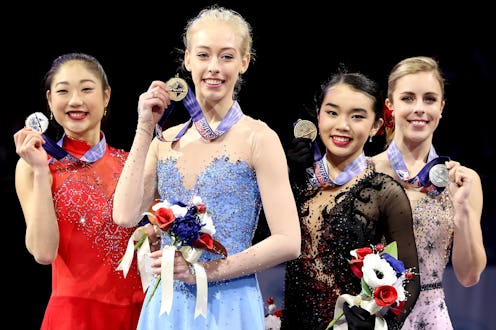Life
Men & Women’s Figure Skating Are Scored Differently — Here’s Why

Figure skating is one of the few sports in which women have a perceived societal advantage, at least in the way of audience attention. (Albeit that advantage is still rooted in some sexist notions regarding female sports which deserved to be examined in their own right.) The U.S. women’s figure skating team for the Olympics tends to be among the most talked about when it comes to athletes during the winter games. And rightfully so: some of the moves female figure skaters perfect are essentially gymnastics on ice while wearing knife-shoes. While there are some notable differences between male and female figure skating, the two are relatively equal.
Let’s Start With Scoring
The way figuring skating is scored is, put simply, kind of complicated. According to NBC’s Olympic website, there are two primary components to skating scores: technical element score (TES) and program component score (PES). TES, as its name suggests, focuses on technique (i.e. jumps and spins) whereas PES has more to do with artist interpretation and performance. Then, those scores are multiplied by a specific number, weighting equally for the overall score.
Here is where men’s figure skating and women’s figure skating is scored a little bit differently.
Figure skating routines consist of two phases: a short program and free skate (also known as a long program).
Men’s short program (which lasts a maximum of two minutes and 50 seconds) is multiplied by a factor of one and their free skate (which lasts between 4:20 and 4:40) is multiplied by a factor of 2.0.
Women’s scores are weighted differently: short programs (which also last 2:50) are multiplied by 0.8 and free skates (which run shorter than men’s, lasting between 3:50 and 4:10) are multiplied by 1.6.
You may have noticed that men’s individual figure skating scores tend to be higher than women’s scores. This is in part due to the way they are weighted and the fact that men skate for longer, allowing them time for more tricks.
Do Men And Women Perform Different Tricks?
Someone, such as myself, who knows very little about the technical side of figure skating could spot some clear differences in performances between male and female figure skaters. Female figure skaters, for example, perform plenty of acts of physical flexibility, extending their leg into a standing split or grabbing their skate from behind and over their head, known as the Biellmann spin. While there are male skaters, like Japan’s Yuzuru Hanyu and American skater Jason Brown, who perform such feats of flexibility, they aren’t as common in male skaters’ routines.
Jump-wise, the biggest difference between male and female skaters is the quad: a jump with four revolutions in the air. While the quad has become something of a staple for male figure skaters, only one female has completed a quad in competition: Japan’s Miki Ando in 2002.
The quad was at the center of a controversy at the 2010 Olympics, when Evan Lysacek won gold without performing the quadruple jump. While not a required jump, some male skaters believed Lysacek’s performance was not worthy of gold simply because he didn’t perform a quad. “Without the quadruple, I’m sorry, but it’s not men,” fellow competitor, Russia’s Yevgeny Plushenko, was quoted saying.
Plushenko implied Lysacek’s performance should have qualified as dancing “rather than skating like a man,” according to a quote from Reuters.
Do Women Have To Wear Skirts? Can Men Wear Tights?
Competition outfits are the other clear difference between male and female figure skating. As two-time Olympic figure skater and NBC Sports analyst Johnny Weir told Cosmopolitan, women are required to wear skirts only if they are not in a full-length bodysuit as of a 2006 rule. “You aren’t allowed to wear just a leotard or bodysuit that looks like a swimsuit,” Weir told Cosmo. “There has to be a skirt if you are doing that. You would get a deduction.”
Weir also told Cosmo that men are penalized if they wear tights that don’t look like pants. “They can wear a tapered pant,” he said, “but if it is a tight, that's a reduction in your score.”
While men and women compete under relatively similar figure skate rules, there are certainly some stipulations that have sexist implications. Things like outfits and expected, gender-specific techniques can play a part not only in whether a skater is perceived by the audience and fellow competitors as “good” but how they are actually scored by the Olympic judges.